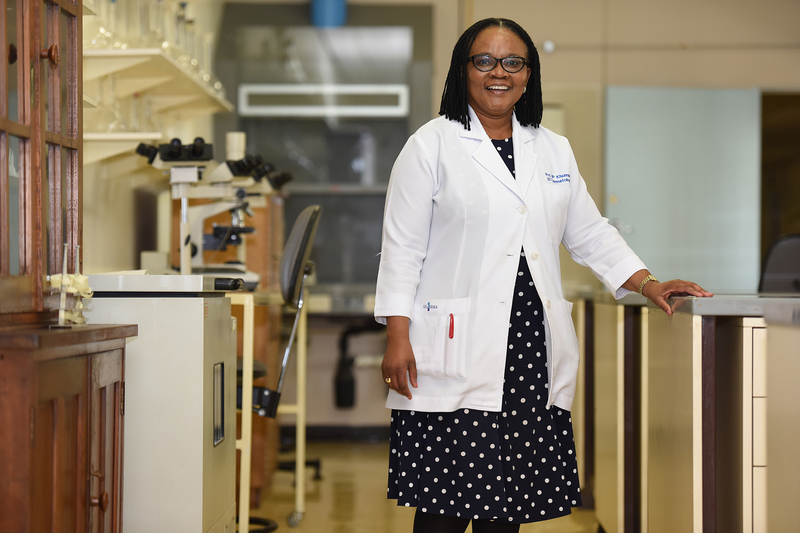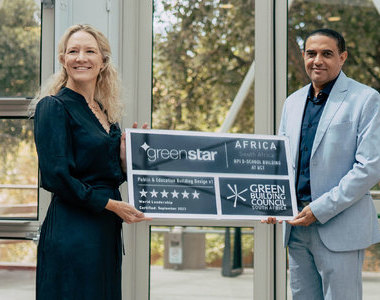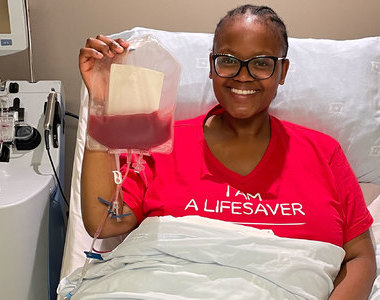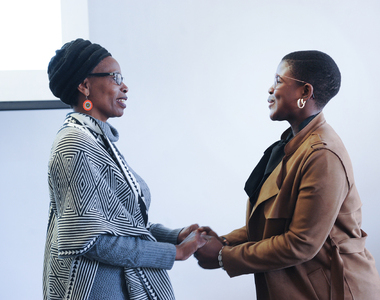First-of-its-kind wound healing research unit
05 September 2019 | Story Staff writer. Photo Je’nine May. Read time 8 min.
UCT Professor Nonhlanhla Khumalo, head of the Division of Dermatology in the Department of Medicine, will direct a new research unit dedicated to understanding and managing skin scarring. Its focus will be keloid scarring, a type of raised scarring that can form when scar tissue grows excessively and that is most common among Africans.
Keloid disease, which disfigures and impairs quality of life of more than 10% of Africans, is a neglected area of research – scientists don’t fully understand why or how it happens.
“Even after surgically removing keloids, they almost always come back,” explains Khumalo.
The UCT Wound and Keloid Scarring (WAKS) Translational Research Unit, to be known in short as the Wound Healing Unit, aims to be a centre of excellence in skin scarring education, research and clinical management. As a translational research unit, it will build on basic scientific research to create techniques and tools that meet critical medical needs.
“Even after surgically removing keloids, they almost always come back.”
The research unit was awarded as one of three under a recent special call from the South African Medical Research Council (SAMRC) for research units led by women researchers. Part of the SAMRC’s long-term goal is to increase support of under-represented scientists engaged in health research.
It will be hosted at the UCT Hair and Skin Research (HSR) Laboratory, the first dermatology laboratory in the country and possibly on the continent.
Normal skin vs scar tissue
Khumalo, a National Research Foundation (NRF) rated researcher, is the founder and director of the state-of-the-art HSR Lab. She will direct the new research unit. Its lead scientist, Professor Ardeshir Bayat, from the University of Manchester and an honorary professor at UCT, is a world-renowned expert in the field of wound healing and keloids.
“The late Professor Bongani Mayosi led a multidisciplinary PhD partnership Newton Fund application between UCT and the University of Manchester. It was this grant – DGEMBE: Developing GEnomic Medicine BEtween Africa and the United Kingdom – that was instrumental in fostering the relationship we have with Professor Bayat,” says Khumalo.
“When Bayat first visited UCT, he was amazed by the setup we had in the lab – the projects and the students – and the synergy between the work we’re doing and his area of interest. On the other hand, I was amazed by his research focus and quality of output in spite of working in a country that has very few patients of African ancestry, the people that are predominantly affected by keloids.
“At the end of it this mammoth study, we hope to be able to draw a map of how a normal scar behaves compared to keloid scarring, compared to folliculitis keloidalis, compared to normal skin.”
“It made sense for us to work together to build up this neglected area of research here in Africa. As a result, I applied for this Extra Mural Research Unit from the SAMRC, which allows us to bring him and his skills to South Africa to collaborate on this area.”
After his initial visit, Bayat began co-supervising students with Khumalo. One of them, Rele Matobole a UCT PhD student, is working on a project to understand the progression of keloid and other abnormal wound healing over time.
“This is the first study of sequential biopsies of normal skin, normal scarring, keloids and folliculitis keloidalis, a type of scar that forms at the back of the head almost exclusively in Africans and primarily among men,” says Khumalo. “We’re trying to understand why these tissues heal differently. This will give us a window into what happens to genes and proteins over time, not just the one time point.
“At the end of it this mammoth study, we hope to be able to draw a map of how a normal scar behaves compared to keloid scarring, compared to folliculitis keloidalis, compared to normal skin.”
Ultimately, their goal is to identify genes and proteins involved in the formation of keloids so that they can move towards developing targeted treatments.
But this is just one aspect of the work Khumalo leads at the HSR Lab, which will be bolstered by the new research unit. The lab is also involved in studying fibrosing poikiloderma (a condition Khumalo was involved in first describing and later identifying a genetic cause for), the pathogenesis of scarring alopecias, the use of hair as a testing substrate in medicine and cosmetic ingredients safety, including offering the new Advanced Diploma in Cosmetic Formulation Science.
A hub of dermatology expertise
Khumalo also plans to build capacity through the Wound Healing Unit.
“Dermatology as a clinical discipline is fantastic in South Africa, that’s why so many of our dermatologists get recruited overseas! But laboratory research is lagging,” she says. “We need to marry the excellent clinical work we already have here with basic sciences so that we can truly understand disease mechanisms and make novel discoveries for treatment.”
Khumalo sees part of her job as building a multi-disciplinary team to work on various aspects of skin and hair research.
“My conviction is that the only way we can be world-leaders in this field is if we grow a critical mass of highly skilled scientists and enable a natural flow from bench to clinic to communities.”
A first for Africa and the world
The UCT Wound Healing Unit plans to establish three-dimensional (3D) tissue culture models, which are closer to conditions of skin scars in the body, and a move away from animal models. These 3D skin models will be used to characterise various biological properties and to conduct high throughput testing of trial treatments for wound healing.
“My conviction is that the only way we can be world-leaders in this field is if we grow a critical mass of highly skilled scientists and enable a natural flow from bench to clinic to communities.”
For the first time in the field, access to a large number of affected patients, cutting-edge equipment, appropriate clinical skills and research expertise will come together in one place in Africa. This will allow the unit to create the best possible environment for the discovery of effective treatments for keloids.
Its work will advance the science of neglected common clinical problems that predominantly affect Africans.
Khumalo also recently applied for and was awarded funding by the Services SETA to move the cosmetic safety work and advanced diploma out of the HSR Lab to the Arise Building: the Africa Research Institute for Skin Health. This is slated for 2021.
 This work is licensed under a Creative Commons Attribution-NoDerivatives 4.0 International License.
This work is licensed under a Creative Commons Attribution-NoDerivatives 4.0 International License.
Please view the republishing articles page for more information.
Listen to the news
The stories in this selection include an audio recording for your listening convenience.























































































































































































































































































































































































